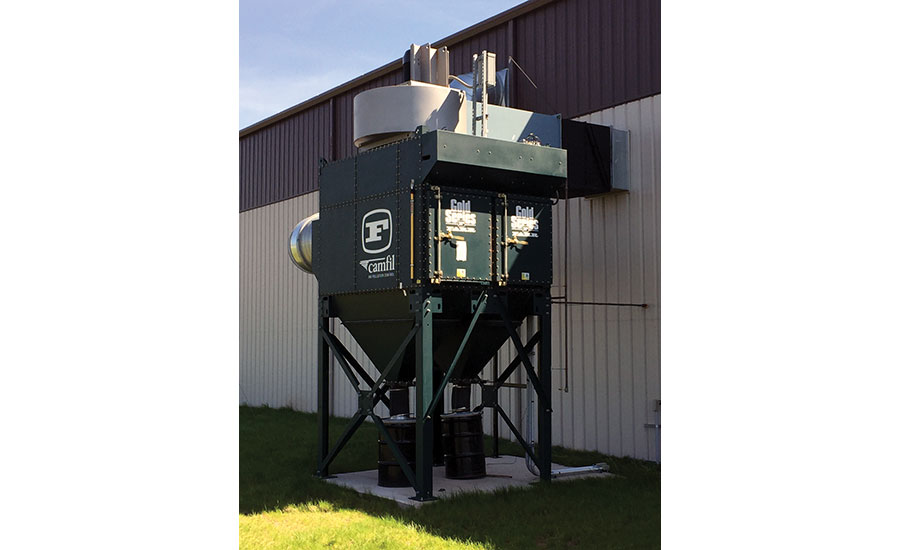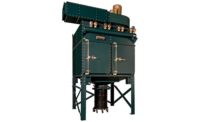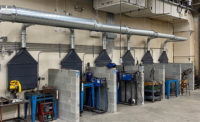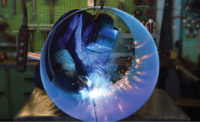Smoke and fumes pose a health and safety risk to weld shops year-round, but winter weather brings special challenges. Now is the time to come up with a solution.
As colder weather arrives, it’s time to reevaluate how you go about controlling the dust and fumes generated during welding. Some of the commonly used “remedies” to fume buildup can be problematic. A proper ventilation system that utilizes a high-efficiency dust collector and recirculates air through the shop is a proven way to keep welding fumes under control in winter months while providing a very good return on investment in energy savings.
Why not just open the shop doors periodically to allow fumes to escape? A fume cloud can build up rapidly in an enclosed facility, especially if there is a high volume of welding and cutting. This can necessitate leaving doors open much of the day, creating a cold and uncomfortable indoor environment where workers are bundled up in heavy clothing. It can be physically difficult for welders and others to perform their everyday work tasks, and it can potentially lead to illness.
Installing exhaust fans is another common approach for removing dirty air from shops. Exhaust fans are often large, noisy and energy-intensive, and they don’t always do the best job of removing dirty air. Often they are used with no regard to providing make-up air into the facility, and when the doors are closed, a negative pressure condition results.
Excessive negative pressure is a safety no-no, as it can cause injury to building occupants from doors slamming shut and can make it very difficult to open doors in an emergency. This condition also allows cold air to seep in through any cracks or weak spots in the structure, creating cold drafts and increased demand for heaters. Following accepted ventilation practices, building air should be neutral or slightly pressurized; and a prescribed percentage of outside air should be conditioned to deliver clean air to occupants at comfortable temperature and humidity levels. In an office building, a good heating and air conditioning system with proper HVAC filtration accomplishes this goal quite effectively. However, this approach will not be sufficient to clean the air of weld fumes or the other heavy contaminant levels generated in industrial environments.
How much fume is too much?
The leading indicators that you have an air quality problem are:
• Visible fume and dust emissions: Some degree of visible fumes is inevitable during welding; but if the cloud grows denser and denser throughout the day, and a blue haze lingers even during breaks, there is probably an issue.
• Worker complaints: Welders complaining of health and discomfort problems are likely being exposed to an excessive level of fumes. Weld fumes are linked to an array of both short- and long-term illnesses and adverse health effects from chronic headaches and fatigue to cancer and respiratory diseases. Complaints should always be taken seriously and addressed as promptly as possible.
• Failure to meet established air quality standards: Air quality testing using air sampling techniques is often performed to ensure that a shop is in compliance with OSHA regulations. OSHA has established permissible exposure limits (PELs) based on eight-hour time weighted average for hundreds of dusts, including the numerous metals contained in welding fumes. By the time a shop fails an air quality test, heavy fume clouds and worker complaints will already be in evidence.
The role of cartridge dust and fume collection
A well-designed cartridge dust/fume collection system will properly filter welding fumes and other hazardous contaminants, and the filtered air can either be exhausted outside or recirculated back into the facility for significant energy savings. These systems use self-cleaning mechanisms that pulse dirt off the filters, allowing units to run for extended periods between filter change-outs.
Whether you are installing a brand new fume collector or updating an existing system that is no longer adequate, there are three general types of fume collection systems to choose from. Source capture systems that utilize flexible arms are popular for applications involving small parts and fixture welding. Ambient systems that filter all the air in the shop using a central system or multiple smaller collectors can serve larger areas, allowing a facility to vary its operations and still capture fumes. Booths, curtains, or custom enclosures with overhead hoods form a middle ground between the two by isolating a specific area for fume collection. With all three types, the fume collector will typically utilize high efficiency pleated filter cartridges. In hazardous applications, the collector may require HEPA secondary filters (also called after-filters) for added filtration and backup protection. Secondary filters are also recommended if you opt to recirculate the filtered air instead of exhausting it outside.
Air recirculation during cold weather months is the single best way to save energy and maximize return on investment with a fume collector. By recirculating heated air back through the plant instead of venting it outdoors, you will see a multitude of savings. The cost to replace the air is eliminated; the cost to heat the replacement air is minimized; the reutilizing of all heat sources within the area saves energy; and blending the warmer air at the ceiling back into the space for a more even temperature at floor level lowers heat loss, while making employees more comfortable.



